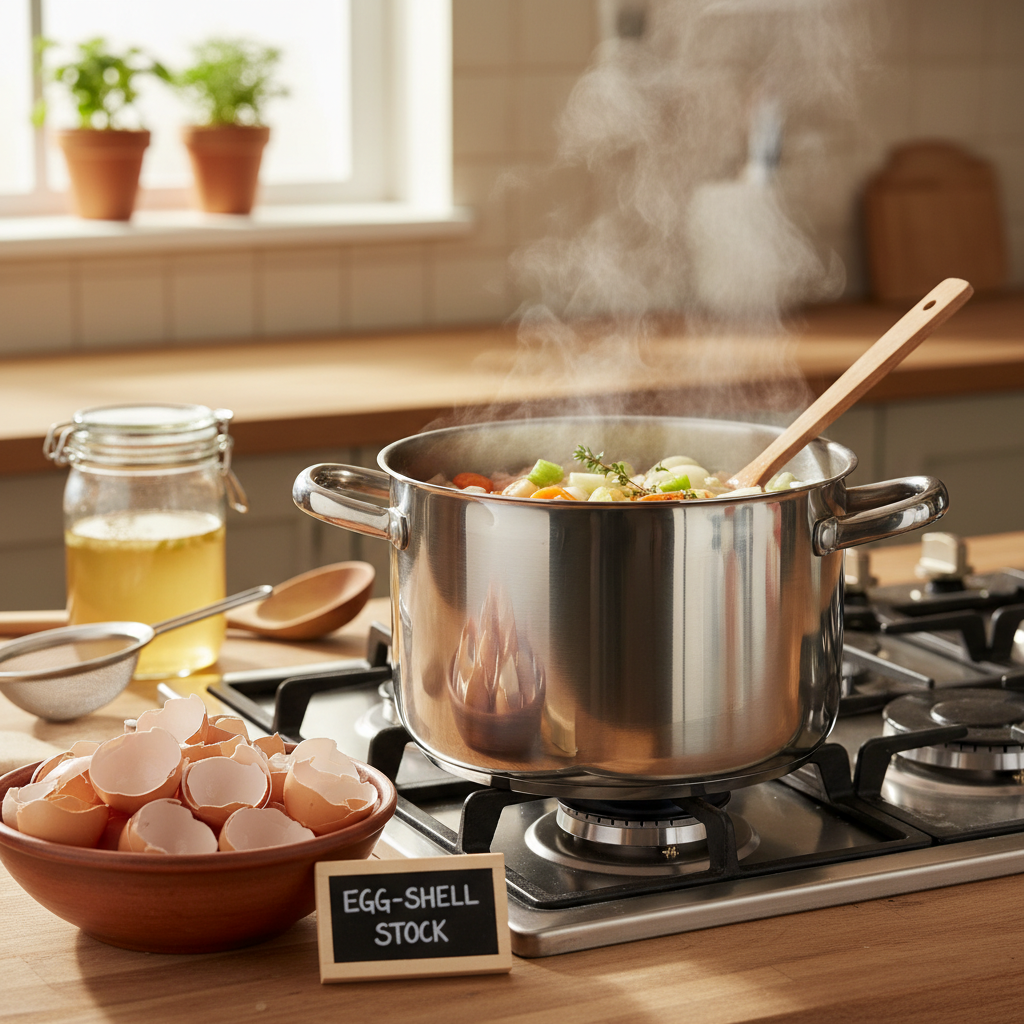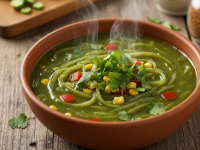Ever found yourself staring at a pile of eggshells, feeling a pang of guilt before tossing them into the bin? I certainly have. For years, eggshells were just… waste. A byproduct of my morning omelets or weekend baking projects, destined for the compost or landfill. But what if I told you those humble shells hold a secret? A culinary hack that not only reduces waste but also enriches your homemade soups and stews with an unexpected depth of flavor and a boost of essential minerals? Trust me, I was skeptical too, but my journey into making eggshell soup stock has been a game-changer, and I can’t wait to share it with you.
My kitchen journey has always been about making the most of every ingredient, pushing for flavor, and minimizing waste. I’ve made stock from chicken bones, vegetable scraps, and even parmesan rinds. But eggshells? That was a bridge too far, or so I thought. Until one day, while scrolling through a forum dedicated to sustainable living and zero-waste cooking, I stumbled upon a discussion about using eggshells in stock. My initial reaction was a mix of curiosity and downright apprehension. “Eggshells in soup? Won’t it taste… chalky? Or worse, will it be safe?”
It turns out, my fears were unfounded. And the more I delved into it, the more I realized I was overlooking a truly valuable resource. This isn’t just about reducing waste; it’s about actively enhancing your food, making it more nourishing and flavorful. So, if you’re ready to challenge your assumptions about kitchen waste and elevate your homemade stocks, let me walk you through my experience and how you can start making your own mineral-rich eggshell soup stock.
Wait, Eggshells? Are You Serious?
I know what you’re thinking because I thought the exact same thing. Putting eggshells in your food sounds a little… unconventional, right? Most of us are conditioned to see eggshells as non-edible, a protective casing to be discarded. But here’s the fascinating part: eggshells are primarily calcium carbonate, which is the same mineral found in many calcium supplements. Beyond that, they contain trace amounts of other beneficial minerals like strontium, magnesium, phosphorus, iron, and zinc.
The magic happens during the long, slow simmering process. When eggshells are heated in water for an extended period, these minerals, especially calcium, slowly leach out into the liquid. This transforms what would otherwise be just plain water or a standard vegetable broth into a subtly richer, more mineral-dense liquid. It doesn’t become chalky, I promise. The key is proper preparation and thorough straining, which we’ll get into.
As for safety, the high heat of simmering effectively sterilizes the shells, eliminating any potential bacteria. The important thing is to start with clean shells, which means rinsing them thoroughly after cracking them open. Once you understand the science, the idea suddenly becomes less bizarre and much more appealing. It moved from a “weird hack” to a “smart culinary technique” in my mind.
Why Bother? The Unexpected Benefits Beyond Zero Waste
So, aside from feeling good about not wasting, what are the tangible benefits of making eggshell stock? Plenty, actually:
Nutritional Powerhouse
- Calcium Boost: This is the big one. Eggshells are an incredibly rich source of bioavailable calcium, vital for bone health, nerve function, and muscle contraction. While the exact amount will vary, adding eggshells to your stock can significantly increase its calcium content, making your meals more nourishing without needing supplements.
- Trace Minerals: As mentioned, eggshells aren’t just about calcium. The trace minerals present, like magnesium (important for muscle and nerve function), potassium (for fluid balance), and zinc (for immune health), contribute to the overall nutritional profile of your stock.
Flavor Enhancer
This was the most surprising benefit for me. I didn’t expect a taste difference, but there is one. The minerals from the eggshells subtly enhance the existing flavors of your stock. Think of it like adding a pinch of sea salt to a dish – it doesn’t make it salty, but it brightens and deepens all the other flavors. The stock gains a bit more body, a rounder mouthfeel, and a unique, savory depth that’s hard to put your finger on but absolutely delicious. It’s not an “eggy” flavor at all, rather an umami enhancement that elevates whatever you use it in.
Sustainability & Cost-Saving
This benefit is perhaps the most obvious. By using eggshells, you’re embracing a truly zero-waste approach in your kitchen. Instead of tossing a valuable resource, you’re transforming it into something useful and beneficial. And let’s be honest, free ingredients are always a win! You’re getting extra nutrients and flavor from something you would have otherwise discarded.
Gathering Your ‘Golden Dust’: Preparing Your Eggshells
The preparation is key to a successful, clean-tasting stock. Don’t worry, it’s very simple.
Collection and Rinsing
Every time you crack an egg, gently rinse the inside of the shell under cold ruing water. You want to remove any remaining egg white or yolk. This is crucial for preventing any ‘eggy’ smell in your stock later.
Removing the Membrane
Inside the shell, there’s a thin, translucent membrane. While not strictly harmful, some people prefer to remove it as it can contribute to a slightly cloudy stock. I usually just give the shell a good scrub with my thumb under ruing water, and the membrane often peels away easily. Don’t stress too much if a tiny bit remains; the long simmer will break it down.
Drying and Storage
Once rinsed and (optionally) de-membraned, place the shells on a paper towel or a clean kitchen cloth to air dry completely. This might take a few hours or overnight. You want them bone dry to prevent mold growth. Once dry, store them in an airtight container (like a jar or a ziploc bag) in your pantry or fridge. I usually have a dedicated “eggshell jar” that I fill up over a week or two until I have enough for a batch of stock.
What Kind of Eggs?
Any chicken eggshells will work. If you have access to organic, free-range eggs, that’s great, but conventional eggshells are perfectly fine too. The mineral composition will be largely similar. The most important thing is cleanliness.
The Magic Happens: Crafting Your Eggshell Soup Stock
Alright, you’ve gathered your shells. Now for the exciting part – turning them into liquid gold!
Ingredients:
- 1-2 cups of clean, dried eggshells (from about 10-15 eggs)
- 8-10 cups of filtered water
- 1 large onion, roughly chopped (peel on is fine!)
- 2 carrots, roughly chopped
- 2 celery stalks, roughly chopped
- 2-3 cloves garlic, smashed
- 1-2 bay leaves
- 1 teaspoon whole black peppercorns
- Optional: A sprig of fresh thyme or parsley stems, a slice of ginger
- A pinch of salt (add more later to taste)
Equipment:
- Large stockpot (4-quart or larger)
- Fine-mesh sieve
- Cheesecloth (optional, but recommended for extra clarity)
Step-by-Step Recipe:
- Crush the Shells: Lightly crush your dried eggshells into smaller pieces. You can do this with your hands or by putting them in a bag and gently pressing. Smaller pieces allow for better mineral extraction.
- Combine Ingredients: Place the crushed eggshells, water, onion, carrots, celery, garlic, bay leaves, peppercorns, and any other optional aromatics into your large stockpot. Add a small pinch of salt.
- Bring to a Simmer: Bring the mixture to a boil over medium-high heat, then immediately reduce the heat to low. The goal is a very gentle simmer, just a few bubbles breaking the surface.
- Simmer for Hours: Cover the pot and let it simmer for at least 4-6 hours, or even up to 8-12 hours for maximum mineral extraction. The longer and slower, the better. Check periodically to ensure it’s still simmering gently and add a little more water if too much evaporates.
- Strain Thoroughly: Once done simmering, carefully remove the pot from the heat. Ladle the contents through a fine-mesh sieve into a large heat-proof bowl or another pot. For an even clearer stock, line your sieve with a few layers of cheesecloth. Press down on the solids to extract as much liquid as possible, but don’t force it too much, or you might push fine particles through. Discard all the solids (including the eggshells).
- Cool and Store: Let the strained stock cool completely before transferring it to airtight containers. You can store it in the refrigerator for up to 5-7 days or freeze it for up to 3-6 months. I often freeze mine in ice cube trays or small portions for easy access.
A personal tip: Don’t let it boil vigorously. A hard boil can make your stock cloudy and can break down the aromatics too quickly. Slow and steady wins the race when it comes to stock!
What to Do with Your Glorious Eggshell Stock
Now that you’ve got this amazing, mineral-rich liquid, what do you do with it? The possibilities are endless!
- Soup Base: This is its primary calling. Use it as the base for any soup recipe – chickeoodle, vegetable stew, lentil soup, ramen broth, or a simple nourishing clear soup.
- Cooking Grains: Use it instead of water to cook rice, quinoa, couscous, or pasta. It will impart a subtle depth of flavor and extra nutrients.
- Sauces and Gravies: Replace plain water or store-bought broth with your eggshell stock in gravies, pan sauces, or casseroles for a richer, more complex flavor.
- Deglazing: After searing meats or vegetables, use a splash of eggshell stock to deglaze the pan, capturing all those delicious browned bits.
I love using it as a direct replacement for store-bought chicken or vegetable broth when I want a lighter, yet deeply satisfying, flavor profile. It’s particularly fantastic in a simple mushroom risotto, where its subtle earthiness and body really shine.
Conclusion: Embrace the Unexpected
My journey from skepticism to wholeheartedly embracing eggshell soup stock has been a delightful surprise. It’s a prime example of how stepping out of our culinary comfort zones and challenging traditional notions of “waste” can lead to incredibly rewarding results. Not only have I reduced my kitchen waste significantly, but I’ve also added a powerful, nutrient-dense, and delicious ingredient to my cooking arsenal.
So, the next time you crack an egg, pause before you toss that shell. Remember the hidden potential within. Give this eggshell soup stock a try. It’s a simple, sustainable, and surprisingly impactful way to bring more flavor, more nutrition, and a little more magic into your everyday cooking. You might just find yourself wondering why you ever threw them away in the first place!




